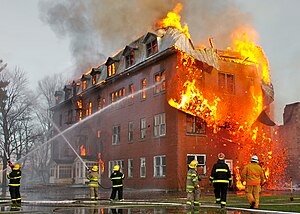
A firefighter is a first responder trained in firefighting, primarily to control and extinguish fires that threaten life and property, as well as to rescue persons from confinement or dangerous situations. Male firefighters are sometimes referred to as firemen.
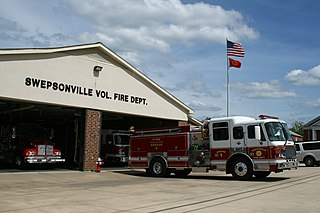
A volunteer fire department (VFD) is a fire department of volunteers who perform fire suppression and other related emergency services for a local jurisdiction. Volunteer and retained (on-call) firefighters are expected to be on call to respond to emergency calls for long periods of time, and are summoned to the fire station when their services are needed. They are also expected to attend other non-emergency duties as well.

Firefighting is a profession aimed at controlling and extinguishing fire. A person who engages in firefighting is known as a firefighter or fireman. Firefighters typically undergo a high degree of technical training. This involves structural firefighting and wildland firefighting. Specialized training includes aircraft firefighting, shipboard firefighting, aerial firefighting, maritime firefighting, and proximity firefighting.
Fire police are fire department members who, based upon their jurisdictional authority, receive sworn police powers, special training, and support firefighting efforts at emergency incidents. In addition to securing firefighting equipment, incident and fire scenes, and the station itself, fire police perform traffic and crowd control. In some jurisdictions, fire police are exterior firefighters and may be called upon at fire scenes to perform any of the duties of an interior firefighter except those that require a self-contained breathing apparatus. On occasion, fire police also assist regular police: they perform road closures, traffic control, crowd control at public events, missing persons searches, parade details, salvage, security, and other miscellaneous tasks as requested.
Firefighting jargon includes a diverse lexicon of both common and idiosyncratic terms. One problem that exists in trying to create a list such as this is that much of the terminology used by a particular department is specifically defined in their particular standing operating procedures, such that two departments may have completely different terms for the same thing. For example, depending on whom one asks, a safety team may be referred to as a standby, a RIT or RIG or RIC, or a FAST. Furthermore, a department may change a definition within its SOP, such that one year it may be RIT, and the next RIG or RIC.

Aircraft rescue and firefighting (ARFF) is a type of firefighting that involves the emergency response, mitigation, evacuation, and rescue of passengers and crew of aircraft involved in aviation accidents and incidents.

The Fire and Rescue Department of Malaysia, commonly known as Bomba, is a federal agency of Malaysia responsible for firefighting and technical rescue. Bomba is a Malay word derived from the Portuguese bombeiros which means 'firefighters'.

Palm Beach County Fire Rescue (PBCFR) is one of the largest fire departments in the state of Florida. With 52 stations, Palm Beach County Fire Rescue provides fire protection, Advanced Life Support, emergency medical services, technical rescue, hazardous materials' mitigation, aircraft rescue/firefighting, fire investigation, and 911 dispatching for unincorporated parts of Palm Beach County, Florida as well as 19 cities under contract.
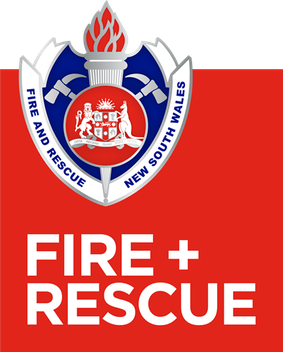
Fire and Rescue NSW (FRNSW) previously known as NSW Fire Brigades (NSWFB), is a agency of the New South Wales Government, Australia. FRNSW is responsible for firefighting, rescue and HAZMAT services in the major cities, metropolitan areas and towns all across the state of New South Wales. Fire and Rescue NSW is the fourth largest urban fire service in the world, with over 6,800 firefighters serving at 335 fire stations throughout the state, supported by 465 administrative and trades staff and 5,700 community fire unit volunteers. FRNSW are the busiest fire service in Australia, attending over 124,000 incidents a year.

Firefighting in Finland is regulated by the Ministry of the Interior. Municipalities of Finland can choose whether the fire and rescue services are provided by a professional fire brigade, a half-ordinary fire brigade or a voluntary fire brigade. Half-ordinary and voluntary fire brigades rely on non-professional voluntary firefighters who have been trained appropriately. The main responsibilities of fire brigades are rescuing people, protecting property and the environment, limiting damage and consequences.
As firefighting has a rich history throughout the world, traditions in this profession vary widely from country to country.
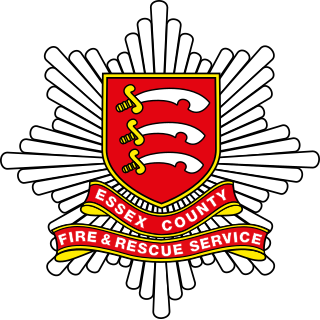
Essex County Fire and Rescue Service (ECFRS) is the statutory fire and rescue service for the county of Essex in the east of England, and is one of the largest fire services in the country, covering an area of 1,338 square miles (3,470 km2) and a population of over 1.7 million people.
Winnipeg Fire Paramedic Service (WFPS) provides fire and EMS services to the City of Winnipeg, Manitoba. It operates from 27 fire stations, and 3 administration offices across the city.
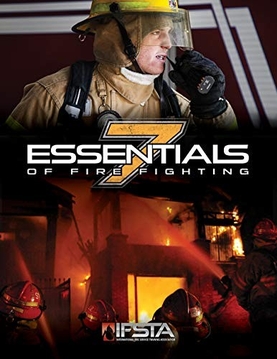
Essentials of Fire Fighting is a fire service training manual produced by Fire Protection Publications (FPP) and the International Fire Service Training Association (IFSTA). Fire Protection Publications is a department of Oklahoma State University College of Engineering, Architecture, and Technology (CEAT) in Stillwater, Oklahoma. This manual is used by fire service training agencies and departments around the world to train personnel to become firefighters. The Essentials of Fire Fighting is the required training manual used in countless local fire departments and state/provincial training agencies in every region of the United States and Canada. Since the release of the first edition of this manual in 1978, more than 2.5 million copies of the Essentials of Fire Fighting have been distributed to the fire service.
An incident response team (IRT) or emergency response team (ERT) is a group of people who prepare for and respond to an emergency, such as a natural disaster or an interruption of business operations. Incident response teams are common in public service organizations as well as in other organizations, either military or specialty. This team is generally composed of specific members designated before an incident occurs, although under certain circumstances the team may be an ad hoc group of willing volunteers.

Firefighting in the United States dates back to the earliest European colonies in the Americas. Early firefighters were simply community members who would respond to neighborhood fires with buckets. The first dedicated volunteer fire brigade was established in 1736 in Philadelphia. These volunteer companies were often paid by insurance companies in return for protecting their clients.

The Cincinnati Fire Department provides fire protection and emergency medical services for Cincinnati, Ohio. The department, which was established on April 1, 1853, was the first fully paid and professional fire department in the United States. Along with being responsible for nearly 80 square miles (210 km2) of land, the department also provides response coverage to 25 miles (40 km) of Ohio River shoreline.
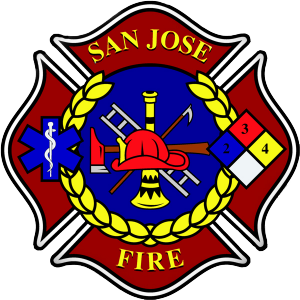
The San José Fire Department (SJFD) provides firefighting, rescue and emergency medical services to the city of San Jose, California, United States. The San Jose Fire Department protects the third largest city in California and the 13th largest city in the nation.
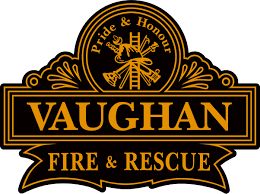
Vaughan Fire and Rescue Services (VFRS) provides fire protection, technical rescue services, hazardous materials response, and first responder emergency medical assistance to the city of Vaughan, Ontario. It operates 10 fire stations and coordinates with other fire departments in York Region and the Greater Toronto Area. VFRS received a 100 per cent satisfaction rating in the City of Vaughan’s 2018 Citizen Survey.
